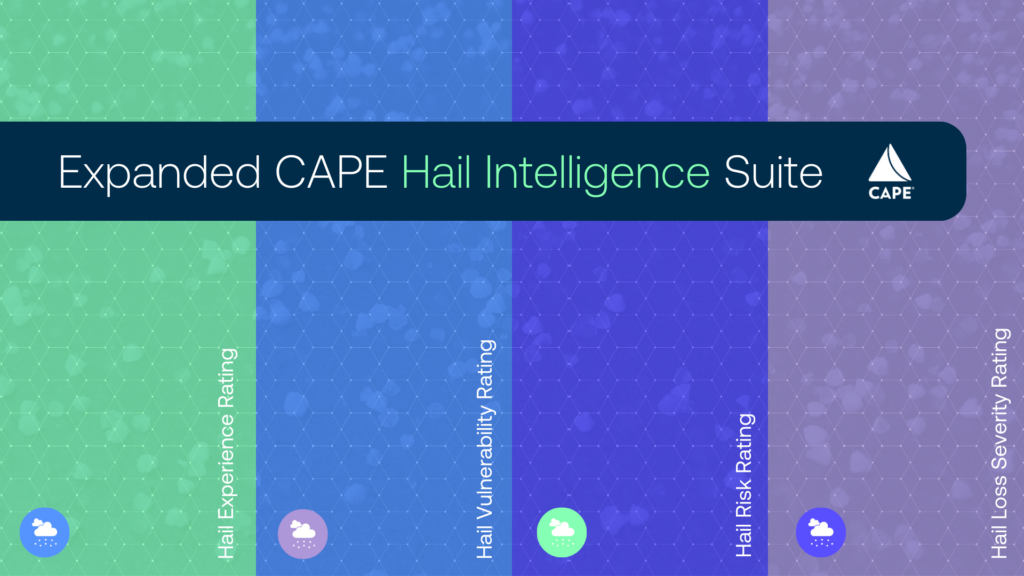
Unveiling the Expanded CAPE Hail Intelligence Suite: Groundbreaking Hail Risk Assessment for Property Insurance Underwriting and Pricing
Hail damage has emerged as a growing challenge for property insurers, leading to significant financial losses. With the increasing frequency and severity of hailstorms, insurance underwriters and actuaries face the daunting task of accurately assessing and managing hail risk. Today, we’re thrilled to introduce our full CAPE Hail Intelligence Suite, a groundbreaking solution that leverages geospatial analytics, AI, weather data from Canopy Weather, and advanced data analysis to transform hail risk assessment, enabling insurers to make more informed decisions and mitigate losses effectively.
Understanding the Hail Problem
Hail is responsible for a staggering 50-80% of thunderstorm-related losses each year. In 2022 alone, insured losses from hail surpassed $20 billion in the United States, with State Farm reporting $3.5 billion in hail-related losses, primarily from homes—a $1 billion increase from 2021. Moreover, although states like Texas and Colorado experience the highest hail-related losses, hail is a peril that impacts most U.S. states. Roofs, being the most vulnerable part of buildings during hailstorms, bear the brunt of this damage. However, the severity and cost of hail damage vary depending on factors such as roof materials, composition, and previous hail experience, which can degrade performance over time.
The Need for Comprehensive Risk Assessment
Recognizing the importance of property characteristics and vulnerability in assessing hail risk, the Insurance Institute for Business & Home Safety (IBHS) emphasizes the significance of factors like roof materials and shapes in determining the damageability of roofs. By capturing these differences, insurers can align premium requirements with the risk profile and offset the increasing losses associated with hail damage. This includes but is not limited to, decisions around providing actual cash value (ACV) versus replacement cost value (RCV) policies.
The CAPE Hail Intelligence Suite takes a pioneering approach to hail assessment by providing insurers with a comprehensive toolkit.
Introducing the Expanded CAPE Hail Intelligence Suite
The expanded CAPE Hail Intelligence Suite is a holistic toolset designed to assess, underwrite, and price hail risk. Powered by advanced machine learning, computer vision, geospatial imagery, and a broad set of historical claims, this suite offers insurers unparalleled insights into hail risk. It includes the following scores:

Hail Experience Rating: This score estimates the likelihood that a property has experienced recent hail damage to its roof, using forensic weather history from Canopy Weather. Properties with a higher number and severity of hailstorms in the previous two years are associated with a 50% higher claim frequency in the near future due to undetected damage. Identifying undetected hail damage allows insurers to better gauge the likelihood of a claim at the point of quote or underwriting review, or to proactively manage potential claims and mitigate financial risks when reviewing an existing book of business.
Hail Vulnerability Rating: By assessing a property’s vulnerability to hail, considering factors such as structure footprint, roof condition, roof covering material, and more, this rating helps insurers understand a property’s susceptibility to hail damage. Properties with high vulnerability in hail-prone states have 2.5X higher hail loss ratios and 3X the claims frequency compared to those with lower hail vulnerability.
Hail Risk Rating: This rating provides insurers with an overall assessment of a property’s risk to hail by combining vulnerability and hail hazard information from Canopy Weather. Properties classified as high hail risk have over seven times the claims frequency and ten times the loss ratio compared to low hail risk homes. Understanding the overall risk profile allows insurers to tailor coverage and pricing more effectively.
Hail Loss Severity Rating: By estimating the potential severity of a future hail claim based on a property’s characteristics, this rating helps insurers gauge the monetary impact of hail damage. A CAPE analysis shows that carriers often underprice homes that are predicted to have higher loss severity. A more accurate estimation of loss severity would enable insurers to better manage claims and pricing strategies.
This suite of powerful hail risk assessment tools empowers insurers with crucial insights to address key questions:
- Does a property going through the application process have undetected hail damage, and could a claim be imminent if it were to be bound?
- What is the risk of a future hail claim for a specific property, and which property characteristics drive its vulnerability?
- If a claim were to occur, what would be the likely severity of the loss based on the property’s characteristics?
By providing answers to these questions, the CAPE Hail Intelligence Suite enables insurers to make data-driven decisions, improve underwriting accuracy, optimize pricing strategies, and proactively manage hail risk.
The CAPE Hail Intelligence Suite represents a significant advancement in hail risk assessment for insurance underwriters and actuaries. With robust analytics and comprehensive, data-driven ratings, insurers can better evaluate, understand, and manage the growing problem of hail damage. By leveraging this innovative solution, insurers can better assess their true exposure, reduce losses, improve profitability, and enhance their overall resilience in the face of the hail challenge.
To learn more about the CAPE Hail Intelligence Suite and discover how it can benefit your organization, reach out to your client development representative and embark on a custom loss experience study today.
Aggregate Statistics Created Using Data Produced from Nearmap Imagery

